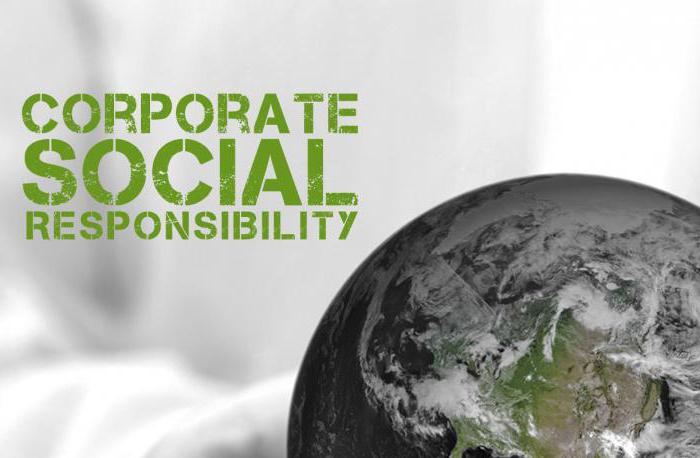Corporate social responsibility is a concept that can be called more relevant for Western countries, and today is still not quite familiar to the hearing of domestic entrepreneurs. However, one cannot fail to say that over time our business also seriously thought about mastering this concept.
What is she like?

Corporate social responsibility began to be used in the world community around the 60s of the 20th century, when this concept began to be actively used at existing enterprises in Canada and the USA. At that time, it was perceived solely as caring for managers about staff, as well as providing assistance to the local government. Back in the 70s, due to the fact that there was an increase in anxiety on the part of people about the state of nature, corporate social responsibility began to include concern about the environmental situation in their country.
Today, Western management experts, considering corporate social responsibility, propose the use of the concept of social protection, which provides that company leaders will pay equal attention to working for profit, as well as taking care of their own employees, partners, customers and events, the main task of which is to guarantee environmental protection.
How is it provided?

The larger the business of a certain company is, the more influential it becomes in relation to the life of the environment, and this applies to its employees, partners, customers, the economic space, as well as all kinds of cultural and educational processes. In this regard, corporate social responsibility provides for the fulfillment of a number of obligations related to both economic properties and social ones. In particular, this concerns the timely payment of taxes, providing subordinates with the most comfortable working conditions, the provision of a number of jobs and much more.
It is worth noting the fact that different companies use a different system to provide subordinates with comfortable conditions, starting from offering a subscription to a fitness club and ending with providing their own housing to those employees who work for a long time. Most often they interpret the concept of corporate social responsibility as the conduct of active charitable activities of the company.
How is charity conducted?

Modern companies are actively involved in the creation of various charitable foundations. Recently, the approach to charity has been gradually changing in society, starting from standard financing of various charitable and public organizations distributing money independently between various objects, and ending with the partnership participation of all parties, that is, the authorities, society and business. Thus, thanks to the active interaction on the part of each of the participants, various social programs appear that are equally interesting to society and are aimed at solving certain social problems. A similar model is today called social partnership.
Levels
The concept of corporate social responsibility is divided into several levels:
- The first.It provides for the implementation of such obligations as the timely payment of taxes, employee salaries, and, if possible, the provision of various new jobs.
- Second. It implies providing each employee with not only adequate working conditions, but also with life, as a result of which staff development, housing construction, preventive treatment, as well as active improvement of the social sphere are carried out.
- Third. The highest level of responsibility, which provides for the conduct of charitable activities.
Internal social responsibility
The development of corporate social responsibility of the internal type provides for the following:
- Ensuring work safety.
- Maintaining a stable wage.
- Maintaining a socially significant salary for each employee.
- Providing additional social and medical insurance for employees.
- Active development human resources using training programs, as well as training programs and further training.
- Assistance to employees in solving various critical situations.
External social responsibility

The organization's external corporate social responsibility includes the following:
- Active sponsorship, as well as corporate charity.
- Promoting environmental protection.
- Interaction with local authorities and society.
- Willingness to take an active part in various crisis situations.
- Ensuring responsibility for the services provided or the goods to the consumer (production of quality products).
Motivation
There are several motives that force modern businessmen to provide various models of corporate social responsibility:
- The development of our own labor collective allows us not only to exclude staff turnover but also helps to attract the best specialists in the current market.
- Labor productivity in own company increases.
- The image of the organization is improving, its reputation is growing.
- It provides advertising for a particular product or service.
- The organization’s activities are beginning to be covered in the media.
- Sustained and stable development of the company in the foreseeable future is ensured.
- There is an opportunity to attract investment for the development of social campaigns.
- Social stability is maintained throughout society.
- Tax credits are used.
Types of programs

There are several common types of social programs:
- Social or administrative budget. It includes various financial resources that the company allocates for the implementation of one or several of its social programs, supported on an ongoing basis.
- Corporate Code. It is a formal definition of the principles and values of the business relationship of the company, and sometimes also of its partners or suppliers. The Code includes the minimum declared costs, as well as the guarantee of the company to fully comply with them and require mandatory compliance from its contractors, subcontractors, suppliers or licensees. The Code cannot be called any law, therefore, it is mandatory only for those companies that independently undertook to comply with it.
- The goal of a socially responsible company. It represents the officially presented position of the organization regarding its own social policy.
- Priorities The documented most important areas that are provided by the implementation of various social programs.
- Social programs.This is the activity of the company, which is carried out voluntarily and aimed at developing its own personnel, creating the most favorable working conditions, protecting nature, supporting local communities, charity activities, and conducting good business practices. Moreover, in this case, the main criterion is the full compliance of programs that provide for corporate and social responsibility of the company, its strategy and business goals.
- Social activity. It is expressed in the active implementation of various social programs that have both external and internal character. As a distinctive feature of social activity programs, it is worth highlighting the absolutely voluntary nature of their implementation, systematic nature, as well as a direct relationship with the main strategy and goal of the company's development.
Types of programs

There are also several types into which social programs are distributed:
- Own.
- Partnerships with federal, local or regional governments.
- Partnerships with various non-profit organizations.
- Collaboration with various professional associations, as well as diverse public organizations.
- Aimed at informative cooperation with various media.
Control
Corporate social responsibility management provides for the leadership of all leading social programs, and this is an ongoing process in the company, which includes several stages:
- Definition of the main goals of the company's social policy.
- Formation of a specialized management structure for active social programs.
- Carrying out various programs aimed at training in the field of social responsibility.
- The implementation of various social programs.
- Evaluation, as well as informing all interested parties about the results of ongoing social programs.
Directions

In addition, the principles of corporate social responsibility provide for the distribution of several areas of social programs.
- Conducting good business practice. This direction of social programs as the main goal provides for the active promotion of the adoption and subsequent cultivation of good business practices among our own customers, partners and suppliers.
- Conservation and conservation of resources. The concept of corporate social responsibility provides for this area as an initiative of the company, and as its main goal is to minimize the harmful effects of the enterprise and its actions on the environment. In particular, all kinds of technologies are beginning to be actively used, aimed at the economical consumption of natural resources, the disposal or reuse of waste, minimizing or completely eliminating environmental pollution, the formation of environmentally friendly production, as well as transportation.
- Active development of the local community. It is also carried out exclusively on a voluntary basis and is intended to make the company's own contribution to the development of the local community. It includes carrying out various actions and social programs to support vulnerable groups of the population, maintaining or further developing the sphere of housing and communal services, sponsoring all kinds of cultural, sports and educational organizations, taking part in charity events.
Employee development
Corporate social responsibility of business considers the development of employees as one of the most important elements of the strategy, and sets as the main goal the attraction and further retention of the most talented employees.In particular, training and professional development of employees are carried out, motivational payroll systems are used, a social package is provided, appropriate conditions for leisure and recreation are created, various internal communications are supported, and the participation of employees in making all kinds of management decisions is ensured.



